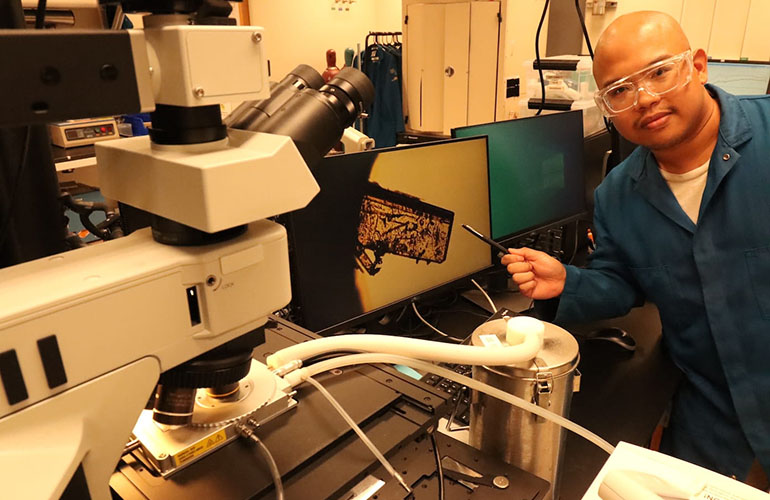
Postdoctoral fellow Dmitri Cordova of UC Irvine examines a sample of the crystal used in Professor Maxx Arguilla’s lab to develop innovative nanothermometers. (Photo: Lucas Van Wyk Joel)
A new class of nanoscale materials that act like microscopic mood rings and change color with temperature could help measure temperatures at the smallest scales. It could have applications in electronics, biology, and beyond. This research, published in Advanced Materials by scientists at the University of California, Irvine, involves a one-dimensional nanoscale material called indium selenium iodide (InSeI).
“We found that we can make really small and sensitive thermometers,” said Maxx Arguilla, a chemistry professor at UC Irvine, in a press release. “It’s one of the most application-oriented and transferable works from our lab.”
Spiral-shaped “Slinkies”
The breakthrough came when postdoctoral fellow Dmitri Cordova and his colleagues grew InSeI crystals in their lab and found that they resembled spiral “slinkies” on the nanometer scale.
The scientists first grew the crystals to expose them to heat stress and to investigate at what temperature the crystals would decay.
Cordova and student Leo Cheng then noticed that the colors of the InSeI crystals systematically shifted from light yellow to red-orange depending on the temperature. Light yellow corresponded to temperatures around -190 °C, while red-orange corresponded to temperatures around 200 °C.
The team performed measurements to calibrate the color changes with temperature. They found that InSeI has a large electron-phonon coupling constant (S = 7.32) and a high temperature sensitivity of the band gap with (dEg/dT)max = 1.26 × 10−3 eV K−1, which is significantly larger than most optically active semiconductors in the visible region.
To obtain nanoscale samples of InSeI, the researchers stuck tape onto the crystals, peeled it off, and transferred the adhered nanostructures onto transparent substrates. “We can peel off these structures and use them as nanothermometers that can be transferred, reconfigured, and coupled to other materials or surfaces,” Arguilla said.
The development of InSeI nanothermometers opens up new possibilities in many fields. In biomedicine, for example, these tiny thermometers could be used to monitor temperature fluctuations in individual cells. “The need to measure temperatures is important because many biological and industrial processes rely on monitoring tiny temperature changes,” said Arguilla. “Perhaps we now have thermometers that we could insert into the cells.”
InSeI could also be integrated into microchips and data storage devices to monitor temperature and prevent overheating. The semiconductor industry already uses optical thermometers in the manufacture of computer components, but the researchers’ new material is “at least an order of magnitude more sensitive,” Dmitri Cordova noted in the press release.
A closer look at how it works
Indium selenium iodide (InSeI) is a van der Waals solid, meaning it consists of layers held together by weak forces. It consists of weakly bonded helical chains that exhibit significant visible thermochromism, shifting their optical absorption edge from 450 to 530 nm over a temperature range of 380 K.
You can think of it like this: the arrangement of atoms in InSeI changes slightly with temperature, changing the way it absorbs and reflects light, resulting in the visible color change. This significant change is the result of strong interactions between electrons and vibrations within the material (electron-phonon interactions) and the way these vibrations behave at different temperatures (anharmonic phonons). This property makes InSeI a promising candidate for highly sensitive optical thermometry at the nanoscale.
